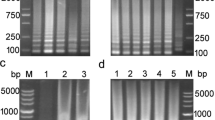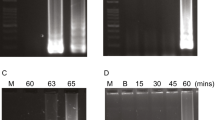Abstract
The aim of this study was to establish a rapid and visual nucleic acid isothermal amplification method for the detection of viable Staphylococcus aureus (S. aureus) in pork and pork products. The method was based on saltatory rolling circle amplification (SRCA) combined with propidium monoazide (PMA). Eighteen S. aureus strains and 29 non-S. aureus strains were used for the specificity evaluation. The sensitivity and detection limit of PMA–SRCA assay through fluorescence visualization were 2.6 × 101 CFU/mL and 6.6 × 101 CFU/mL, respectively. Compared with PMA–PCR assay, the PMA–SRCA method by fluorescence visualization exhibited a 1000-fold higher sensitivity. A total of 123 pork samples were tested for S. aureus contamination, and the results indicated that the relative sensitivity, specificity and accuracy of PMA–SRCA method were 100, 99.12 and 99.19%, respectively, compared with ISO method. In conclusion, the PMA–SRCA assay can reduce the false-positive detection rate of S. aureus in pork and pork products.




Similar content being viewed by others
References
Lin L, Gu Y, Cui H (2019) Moringa oil/chitosan nanoparticles embedded gelatin nanofibers for food packaging against Listeria monocytogenes and Staphylococcus aureus on cheese. Food Packag Shelf 19:86–93
Omiccioli E, Amagliani G, Brandi G, Magnani M (2009) A new platform for real-time PCR detection of Salmonella spp., Listeria monocytogenes and Escherichia coli O157 in milk. Food Microb 26:615–622
Scallan E, Hoekstra RM, Angulo FJ, Tauxe RV, Widdowson MA, Roy SL, Jones JL, Griffin PM (2011) Foodborne illness acquired in the United States—Major pathogens. Emerg Infect Dis 17:7–15
Hu W, Li C, Dai J, Cui H, Lin L (2019) Antibacterial activity and mechanism of Litsea cubeba essential oil against methicillin-resistant Staphylococcus aureus (MRSA). Ind Crop Prod 130:34–41
Shan Y, Xu C, Wang M, Zhu Z, Wu FG, Shi Z, Cui Q, Arumugam GM (2019) Bilinear Staphylococcus aureus detection based on suspension immunoassay. Talanta 192(15):154–159
Zhong Q, Tian J, Wang B, Wang L (2016) PMA based real-time fluorescent LAMP for detection of Vibrio parahaemolyticus in viable but non-culturable state. Food Control 63:230–238
Sartori C, Boss R, Ivanovic I, Graber HU (2017) Development of a new real-time quantitative PCR assay for the detection of Staphylococcus aureus genotype B in cow milk, targeting the new gene adlb. J Dairy Sci 100:7834–7845
Vancraeynest D, Haesebrouck F, Hermans K (2007) Multiplex PCR assay for the detection of high virulence rabbit Staphylococcus aureus strains. Vet Microb 121:368–372
Kumar BK, Raghunath P, Devegowda D, Deekshit VK, Venugopal MN, Karunasagar I (2011) Development of monoclonal antibody based sandwich ELISA for the rapid detection of pathogenic Vibrio parahaemolyticus in seafood. Int J Food Microb 145(1):244–249
Lizardi PM, Huang X, Zhu Z, Bray-ward P, Thomas DC, Ward DC (1998) Mutation detection and single-molecule counting using isothermal rolling-circle amplification. Nat Genet 19(3):225–232
Zyrina NV, Zheleznaya LA, Dvoretsky EV, Vasiliev VD, Andrei C, Matvienko NI (2007) N.BspD6I DNA nickase strongly stimulates template-independent synthesis of non-palindromic repetitive DNA by Bst DNA polymerase. Biol Chem 388:367–372
Oliver JD (2010) Recent findings on the viable but nonculturable state in pathogenic bacteria. FEMS Microb Rev 34:415–425
Li L, Mendis N, Trigui H, Oliver JD, Faucher SP (2014) The importance of the viable but non-culturable state in human bacterial pathogens. Front Microb 5(258):1–20
Bai H, Zhao F, Li M, Qin L, Yu H, Lu L, Zhang T (2019) Citric acid can force Staphylococcus aureus into viable but nonculturable state and its characteristic. Int J Food Microb 305:1082542
Chang B, Taguri T, Sugiyama K, Amemura-Maekawa J, Kura F, Watanabe H (2010) Comparison of ethidium monoazide and propidium monoazide for the selective detection of viable legionella cells. Jpn J Infect Dis 63(2):119–123
Scariot MC, Venturelli GL, Prudencio ES, Arisi ACM (2018) Quantification of Lactobacillus paracasei viable cells in probiotic yoghurt by propidium monoazide combined with quantitative PCR. Int J Food Microb 264(2):1–7
Cattani F, Barth VC, Nasário JSR, Ferreira CAS, Oliveira SD (2016) Detection and quantification of viable Bacillus cereus group species in milk by propidium monoazide quantitative real-time PCR. J Dairy Sci 99(4):2617–2624
Lv XC, Li Y, Qiu WW, Wu XQ, Xu BX, Liang YT, Liu B, Chen SJ, Rao PF, Ni L (2016) Development of propidium monoazide combined with real-time quantitative PCR (PMA-qPCR) assays to quantify viable dominant microorganisms responsible for the traditional brewing of Hong Qu glutinous rice wine. Food Control 66:69–78
Chang CW, Lin MH (2017) Optimization of PMA-qPCR for Staphylococcus aureus and determination of viable bacteria in indoor air. Indoor Air 28(1):64–72
Nocker A, Cheung CY, Camper AK (2006) Comparison of propidium monoazide with ethidium monoazide for differentiation of live vs. dead bacteria by selective removal of DNA from dead cells. J Microb Meth 67:310–320
Davis C (2014) Enumeration of probiotic strains: review of culture-dependent and alternative techniques to quantify viable bacteria. J Microb Meth 103:9–17
Lv X, Huang Y, Liu D, Liu C, Shan S, Li G, Duan M, Lai W (2019) Multicolor and ultrasensitive enzyme-linked immunosorbent assay based on the fluorescence hybrid chain reaction for simultaneous detection of pathogens. J Agr Food Chem 67:9390–9398
Dorn-In S, Gareis M, Schwaiger K (2019) Differentiation of live and dead Mycobacterium tuberculosis complex in meat samples using PMA qPCR. Food Microb 84:103275
Truchado P, Gil MI, Kostic T, Allende A (2016) Optimization and validation of a PMA qPCR method for Escherichia coli quantification in primary production. Food Control 62:150–156
Yan M, Xu L, Jiang H, Zhou Z, Zhou S, Zhang L (2017) PMA-LAMP for rapid detection of Escherichia coli and shiga toxins from viable but non-culturable state. Microb Pathogenesis 105:245–250
ISO. Microbiology of the food chain-Method validation-Part 2: Protocol for the validation of alternative (proprietary) methods against a reference method (ISO 16140–2:2016). International Organization for Standardization (ISO), Geneva, Switzerland
Vazquez-Sanchez D, Cabo ML, Ibusquiza PS, Rodriguez-Herrera JJ (2014) Biofilm-forming ability and resistance to industrial disinfectants of Staphylococcus aureus isolated from fishery products. Food Control 39:8–16
Zhang Z, Liu W, Xu H, Aguilar ZP, Shah NP, Wei H (2015) Propidium monoazide combined with real-time PCR for selective detection of viable Staphylococcus aureus in milk powder and meat products. J Dairy Sci 98:1625–1633
Wang XM, Teng D, Tian F, Guan QF, Wang JH (2012) Comparison of three DNA extraction methods for feed products and four amplification methods for the 5′-junction fragment of roundup ready soybean. J Agr Food Chem 60:4586–4595
Sheet OH, Grabowski NT, Klein G, Abdulmawjood A (2016) Development and validation of a loop mediated isothermal amplification (LAMP) assay for the detection of Staphylococcus aureus in bovine mastitis milk samples. Mol Cell Probe 30:320–325
Xu J, Guo L, Maina SW, Yang Y, Hu Y, Li X, Qiu J, Xin Z (2018) An aptasensor for staphylococcus aureus based on nicking enzyme amplification reaction and rolling circle amplification. Anal Biochem 549:136–142
Wang L, Zhong QP, Li Y (2012) Ethidium monoazide-loop mediated isothermal amplification for rapid detection of Vibrio parahaemolyticus in viable but non-culturable state. Energy Procedia 17:1858–1863
Kobayashi H, Oethinger M, Tuohy M, Hall G, Bauer T (2009) Unsuitable distinction between viable and dead Staphylococcus aureus and Staphylococcus epidermidis by ethidium bromide monoazide. Lett Appl Microb 48:633–638
Li X, Xiong Y, Fan X, Zhong Z, Feng P, Tang H, Zhou T (2008) A study of the regulating gene of femA from methicillinresistant Staphylococcus aureus clinical isolates. J Int Med Res 36:420–433
Johnson S, Kriiger D, Labischinski H (1995) FemA of Staphylococcus aureus: Isolation and immunodetection. FEMS Microb Lett 132:221–228
Liu Y, Mustapha A (2014) Detection of viable Escherichia coli O157:H7 in ground beef by propidium monoazide real-time PCR. Int J Food Microb 170:48–54
Liu Y, Zhong Q, Wang J, Lei S (2018) Enumeration of Vibrio parahaemolyticusin VBNC state by PMA-combined real-time quantitative PCR coupled with confirmation of respiratory activit. Food Control 91:85–91
Youn SY, Jeong OM, Choi BK, Jung SC, Kang MS (2017) Application of loop-mediated isothermal amplification with propidium monoazide treatment to detect live Salmonella in chicken carcasses. Poultry Sci 96:458–464
Chen J, Wang Y, Liu X, Chen G, Chen X, Chen J, Liu Z, Gong Z, Yang G, Lan Q (2018) Development of propidium monoazide-recombinase polymerase amplification (PMA-RPA) assay for rapid detection of Streptococcus pyogenes and Streptococcus agalactiae. Mol Cell Probe 41:32–38
Funding
This work was supported by the National Natural Science Foundation of China (31371772), the Natural Science Foundation of Hebei Province (C2019204342), Postdoctoral Foundation of Hebei Province (B2021005007), and the Key Research and Development Project of Hebei Province of China (18275501D).
Author information
Authors and Affiliations
Corresponding author
Ethics declarations
Conflict of interest
No competing financial interests exist.
Ethical approval
This article does not contain any studies with human or living animal subjects.
Additional information
Publisher's Note
Springer Nature remains neutral with regard to jurisdictional claims in published maps and institutional affiliations.
Supplementary Information
Below is the link to the electronic supplementary material.
217_2022_3990_MOESM2_ESM.tif
Supplementary file2 (TIF 3866 KB) Supplementary Fig 1 The schematic diagram of SRCA assay The lines in black indicate the target double strands DNA. The line in red and orange indicates the nucleotides added at the intersection and their complementary sequence. The forward primer (FWP) initiates an SRCA reaction. And the DNA strands is cyclized and the nucleotides are added at the junction of non-closed circular linear DNA under the action of Bst DNA polymerase. When the synthesized sequence crossed the gap, the newborn DNA strand is displaced. Subsequently, the reverse primer (RVP) binds to each tandem repeat (including target sequence and the added bases) generated by the rolling circle. To track the order of added bases, note that the addition sequence is composed of a few bases from either FWP or the complementary sequence of RVP, or both. With the elongation of original SRCA strand triggered by FWP, multiple priming events are initiated by RVP and the new generated DNA strands are displaced, thus generating new priming sites for FWP. A new branch begins to be displaced by RVP at the nth repeat, as RVP binds to the (n+1) th repeat. Subsequently, FWP bind to the replaced single strand DNA, generating double strand DNA with different repeats, and so on.
Rights and permissions
About this article
Cite this article
Guo, W., Yang, Q., Zhang, Y. et al. Rapid and visual detection of viable Staphylococcus aureus in pork and pork products by PMA and saltatory rolling circle amplification. Eur Food Res Technol 248, 1625–1634 (2022). https://doi.org/10.1007/s00217-022-03990-4
Received:
Accepted:
Published:
Issue Date:
DOI: https://doi.org/10.1007/s00217-022-03990-4




